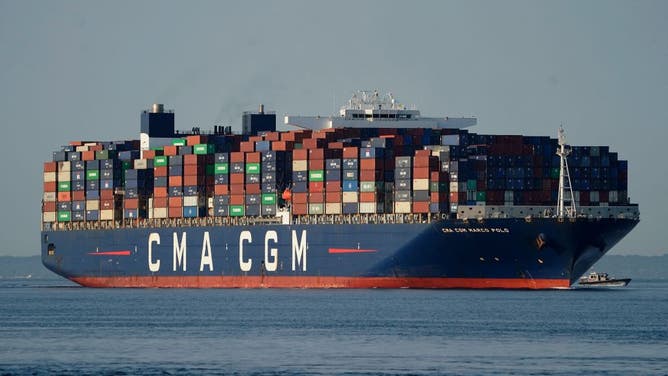How much is literally a ‘boatload of rain’?
Have you ever stopped to wonder just exactly how much is a boatload of rain? Because we can calculate that...

The CMA CGM Marco Polo,an ultra-large container vessel with a maximum capacity of 16,022 twenty-foot equivalent units, passes on May 20, 2021 in New York.
(TIMOTHY A. CLARY / AFP / Getty Images)
It's one of those dreary, stormy days when you look out the window, and it's just been pouring for hours. Your friend texts: "What's up?" And you reply: "Just sitting here staring at the boatload of rain falling outside."
Sure, a figure of speech. But have you ever stopped to wonder just exactly how much is a boatload of rain? Because we can calculate that.
Let's pretend you're at one of America's busy ports, like Los Angeles or Seattle or New York, and one of those enormous container ships arrives with each container full of rain. (Well, maybe not Los Angeles because the last thing they're getting delivered is a boatload of rain.)
Let's begin by figuring out how much water is in each container. According to multiple shipping companies (like this one), each container is 20 feet by 8 feet by 8 feet in size, with a few inches off each measurement for calculating the inside storage capacity.

Shipping containers stacked on the deck of a ship at the Port of Felixstowe Ltd., a subsidiary of CK Hutchison Holdings Ltd., in Felixstowe, U.K., on Thursday, June 24, 2021.
(Chris Ratcliffe/Bloomberg / Getty Images)
Multiply the three dimensions together, and you get about 1,160 cubic feet of water storage in each container. The number of containers each ship carries varies by size and whether they want to fit through the Panama Canal, but a good number these days is about 18,000 containers.
So that ship could conceivably carry almost 21 million cubic feet of water. (Wow! That is a boatload of rain!)
What if it all spilled on a city?
Let's use Manhattan for our example, which is 22.82 square miles, according to Google.
According to United States Geological Survey calculations, if we used all the water on that boat as an exclusive moisture source for a cloud and dumped it over Manhattan, nearly 0.40 inches of rain would fall. That’s quite a bit of rain. Typical passing thunderstorms might only drop 0.10 to 0.20 inches. (If you also wanted to cover the other four boroughs, it would only have enough for about 0.03 inches of rain.)
How much is a ‘boatload of rain’ in your town?
Don't live in New York? You can calculate a boatload of rainfall for your town as well. First, find the square mileage of your town — asking your favorite web search engine or smart speaker should net the answer — and put it in the handy USGS calculator here under Method C. Next, select 1/100 inches for rainfall amount.
Have it run the calculations, and the site will show the number of cubic feet of water used to make 0.01 inches of rainfall.
This is where the math gets a bit tricky, but next, take 21 million (20,880,000 if you want to get closer, though even that has some rounding involved) and divide by that number of cubic feet the USGS site just calculated.
Now, multiply that result by 0.01, and that's how much rain would have to fall to be literally considered a boatload of rainfall for your town.
Hey, aren’t we ignoring gravity?
Well, yes, we are. It turns out, water is heavy. If we literally tried to import a boatload of rain, the ship would likely sink long before we got to fill 'er up.
According to inchcalculator.com, 20.88 million cubic feet of water would weigh just over 1.3 billion pounds or 650,000 tons. Each container alone would weigh just over 72,000 pounds – well above the legal limit of 55,000 pounds for the most robust containers.
So don’t think about trying this experiment at home. We’ll have to leave it as a figure of speech!